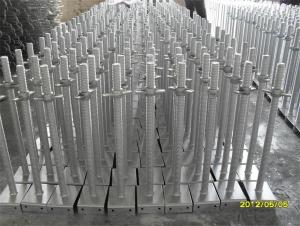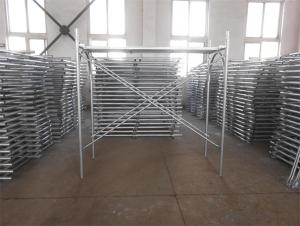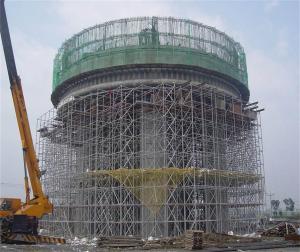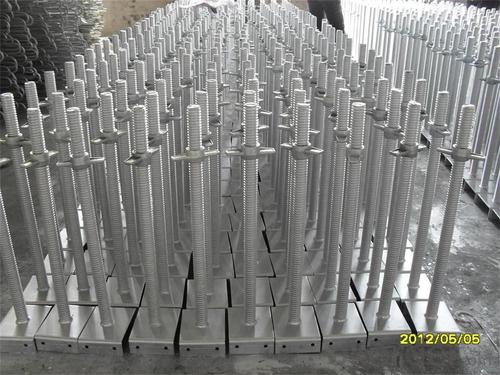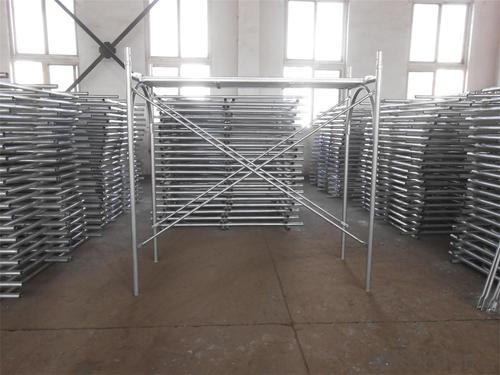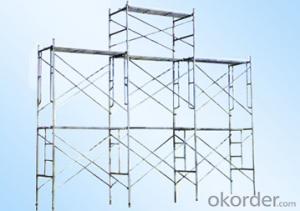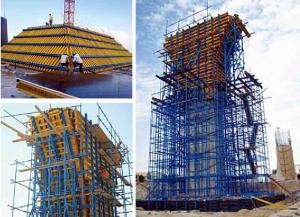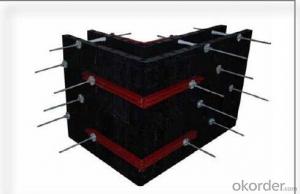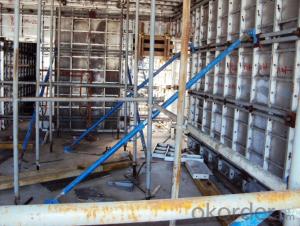Ring lock or Tower Scaffolding with Hot or Cold Galvanized Surface
- Loading Port:
- Shanghai
- Payment Terms:
- TT OR LC
- Min Order Qty:
- 1000 m²
- Supply Capability:
- 100000 m²/month
OKorder Service Pledge
OKorder Financial Service
You Might Also Like
1.Structure of Ring lock Description
Ringlock Scaffolding system is the most popular used Scaffolding system in the world.It will greatly reduce the cost because of the following advantages
Packaging & Delivery
Packaging Details:
Pallet or bag or upon client's request
Delivery Detail:
35days
2.Main Features of Ringlock
It will greatly reduce the cost because of the following advantages
1)Using less pipes
2)Easy to install
3)It can be used again and again for nearly 20years
3.Ring lock product pictures:
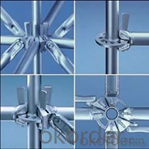
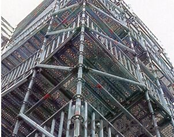
4.Ringlock Product Description
Type: ringlock scaffolding diagonal Brace
specification : Ø48.3×3.20
material:: steel Q235
Finished: Hot DIP galvanized, painted
Diagonal length(m) :Weight(kg)
0.9m * 1.25m 6.28
1.25m * 2.7m 11.45
5.FAQ
We have organized several common questions for our clients,may help you sincerely:
1)How about your company?
CNBM International Corporation, China National Building Materials (Group) Corporation, is one of the largest companies in China building material equipment industry, Our formwork and scaffolding are largely used in both domestic and all over world;
2)How many Scaffolding your company have?
Here comes our 5 types of Scaffolding systems:
- Cup lock Scaffolding(C-Lock Scaffolding)
- Ring lock Scaffolding
-Kwistage Scaffolding
-H-frame Scaffolding
-ID15 Scaffolding Tower, this type Scaffolding is the most widely used in construction, such like bridge.
3)How long can we receive the product after purchase?
Lead time is about 30days after getting the signed PI and deposit.
- Q: Are there any specific requirements for bracing steel frame formwork?
- Yes, there are specific requirements for bracing steel frame formwork. These requirements are in place to ensure the stability and safety of the structure during the construction process. Firstly, it is important to have a comprehensive understanding of the design and structural requirements of the steel frame formwork system. This includes the load-bearing capacity, the maximum height and width of the formwork, and the specific bracing details provided by the manufacturer or structural engineer. The bracing system should be designed to resist the lateral loads and forces that may act on the formwork during concrete pouring and curing. This includes wind loads, pressure from the wet concrete, and any other potential forces that may be present on the construction site. The bracing should be securely anchored to the ground or to other structural elements to provide stability and prevent any movement or collapse of the formwork. The anchoring method should be appropriate for the specific site conditions and take into account factors such as soil type, foundation strength, and potential lateral forces. It is also important to regularly inspect and maintain the bracing system to ensure its effectiveness throughout the construction process. This may include checking for any signs of damage, corrosion, or weakening of the bracing components, and promptly addressing any issues that may arise. In summary, the specific requirements for bracing steel frame formwork include thorough understanding of the design and structural requirements, designing the bracing to resist lateral loads, securely anchoring the bracing system, and regularly inspecting and maintaining the bracing components. Meeting these requirements will help ensure the stability and safety of the steel frame formwork during construction.
- Q: Can steel frame formwork be used for power plant structures?
- Yes, steel frame formwork can be used for power plant structures. Steel frame formwork is versatile and strong, making it suitable for various types of construction projects, including power plant structures. It provides stability and durability necessary for the construction of these large-scale industrial facilities.
- Q: How does steel frame formwork contribute to the overall soundproofing of a structure?
- The main function of steel frame formwork is to provide temporary support and shape to the concrete during construction. However, it's important to note that soundproofing in a structure is typically achieved through the use of specific building materials and techniques. Soundproofing techniques involve the use of insulation materials such as acoustic foam or mineral wool, as well as the installation of soundproof windows and doors. Steel frame formwork, on its own, does not directly contribute to soundproofing. However, it can indirectly influence the overall soundproofing of a structure. During the construction process, including the installation of steel formwork, it is crucial to ensure precision to avoid any gaps or cracks that could allow sound to pass through. By ensuring a tight and well-constructed concrete structure, the overall soundproofing of the building can be improved. Besides, the use of steel frame formwork may also impact the weight and density of the structure, which can indirectly affect its soundproofing properties. A heavier and denser structure tends to provide better sound insulation. However, it's worth noting that the influence of steel frame formwork on the weight and density of the structure may be relatively minimal compared to other factors such as wall construction materials and insulation. To summarize, while steel frame formwork does not directly contribute to the overall soundproofing of a structure, it can indirectly influence it by ensuring a well-constructed concrete structure and potentially impacting the weight and density of the building. However, achieving effective soundproofing requires the use of dedicated soundproofing materials and techniques specifically designed for that purpose.
- Q: What are the different types of formwork clamps used with steel frame formwork systems?
- Formwork systems commonly utilize various types of clamps to securely hold the formwork panels together, ensuring stability and accuracy during the concrete pouring process. 1. Wedge clamps, which are inserted between the formwork panels and tightened with a hammer, are a popular choice for temporary formwork systems due to their ease of installation and removal. 2. Hook clamps, designed with a hook-shaped design, easily attach to the steel frame. They are often used alongside wedge clamps to provide additional stability and prevent any movement of the formwork panels. 3. Rapid clamps, with their lever mechanism, allow for quick and efficient installation. These clamps are commonly employed in large-scale construction projects where time is of the essence. 4. Adjustable clamps have a flexible design that allows them to accommodate different sizes of formwork panels. They are particularly useful when working with irregularly shaped or custom-sized formwork. 5. Panel clamps, specifically designed to hold the formwork panels together at the edges, typically feature a spring-loaded mechanism for a strong grip and tight securing of the panels. Ultimately, the selection of formwork clamps depends on the specific project requirements, including the size and shape of the formwork panels, desired stability level, and installation speed. It is crucial to choose the appropriate clamps to ensure the safety and efficiency of the formwork system.
- Q: Can steel frame formwork be used for architectural and artistic projects?
- Certainly, steel frame formwork is a viable option for both architectural and artistic endeavors. The utilization of steel frame formwork offers numerous advantages that render it suitable for such undertakings. To begin, the strength and durability provided by steel frame formwork allow it to withstand the immense pressure and weight of the concrete during construction. Consequently, this makes it ideal for fashioning intricate and intricate architectural designs that demand precision and stability. Moreover, steel frame formwork can be easily tailored and fabricated to fulfill the unique requirements of artistic projects. It can be effortlessly shaped and welded to generate distinctive and complex forms, enabling architects and artists to actualize their creative visions. Furthermore, steel frame formwork guarantees exceptional dimensional accuracy, ensuring that the final structure aligns with the intended design. This quality is especially critical for architectural and artistic ventures in which precise measurements and shapes are crucial. In addition, steel frame formwork can be reused multiple times, making it an economically viable choice for projects that necessitate the repetitive use of the formwork. This aspect proves particularly advantageous for artistic projects that may entail the creation of multiple similar structures. In conclusion, steel frame formwork provides a versatile and dependable solution for architectural and artistic projects. Its strength, durability, customization capabilities, dimensional accuracy, and reusability render it an ideal option for constructing visually stunning and structurally sound edifices.
- Q: Can steel frame formwork be used for both straight and curved walls?
- Yes, steel frame formwork can be used for both straight and curved walls. Its flexibility and strength allow it to adapt to various wall shapes and sizes, providing a versatile solution for construction projects.
- Q: What are the different types of lifting devices used with steel frame formwork?
- There are several types of lifting devices that are commonly used with steel frame formwork in construction projects. These devices are designed to safely lift and move the formwork components, allowing for efficient and effective installation and removal. 1. Tower Cranes: Tower cranes are commonly used in large-scale construction projects. These cranes have a tall tower structure and a rotating arm that can lift and move heavy loads. Tower cranes are often used to lift and position steel frame formwork components, ensuring precise placement. 2. Mobile Cranes: Mobile cranes are versatile lifting devices that can be easily transported to different construction sites. These cranes are equipped with a telescopic boom and a hook or grab attachment, allowing for efficient lifting and moving of steel frame formwork. Mobile cranes come in various sizes and capacities to suit different project requirements. 3. Forklifts: Forklifts are commonly used in construction sites to lift and transport heavy materials. They have a pair of forks at the front that can be inserted under the steel frame formwork components to lift and move them. Forklifts are ideal for smaller-scale projects or areas with limited space. 4. Hoists: Hoists are vertical lifting devices that are commonly used in construction projects. They can be fixed or portable and are often used to lift and lower steel frame formwork components. Hoists are typically operated using an electric or manual system and can be easily controlled to ensure precise positioning. 5. Chain Blocks: Chain blocks, also known as chain hoists, are manual lifting devices that use a chain and pulley system to lift and move heavy loads. They are commonly used in areas where electricity is not readily available or where precise control is required. Chain blocks are often used to lift and position steel frame formwork components in smaller construction projects. Overall, the different types of lifting devices used with steel frame formwork provide construction teams with a range of options to efficiently and safely handle these components. The choice of lifting device depends on the scale of the project, the available space, and the specific requirements of the formwork installation and removal process.
- Q: How does steel frame formwork help in achieving accurate concrete thickness?
- Achieving accurate concrete thickness is made possible through the use of steel frame formwork, which provides a rigid and stable structure for pouring and shaping the concrete. Acting as a mold or template, the steel frame holds the wet concrete in place until it sets and hardens. One of the primary benefits of steel frame formwork is its resistance to deformation or movement during the pouring and curing process. This guarantees that the concrete maintains its intended thickness and shape, leading to precise and consistent outcomes. Furthermore, the steel frame formwork allows for precise control over the dimensions and alignment of the concrete. It can be adjusted and leveled to the desired thickness, ensuring that the concrete is poured to the correct depth. This feature is particularly crucial in applications where specific thickness requirements are essential, such as in constructing walls, slabs, or columns. Moreover, the steel frame formwork provides a smooth and even surface finish to the concrete. The sturdy structure of the steel frame prevents any bulges, warping, or irregularities, resulting in a uniformly thick concrete structure. This not only enhances the aesthetic appeal of the final product but also ensures its structural integrity. In summary, steel frame formwork plays a vital role in achieving accurate concrete thickness by offering stability, precision, and control throughout the pouring and shaping process. Its resistance to deformation and ability to maintain dimensional accuracy guarantee that the concrete meets the required thickness specifications, resulting in resilient and high-quality structures.
- Q: How does steel frame formwork handle concrete curing in dry conditions?
- Steel frame formwork, composed of steel frames, is utilized to support and secure the concrete while it cures. When it comes to dealing with concrete curing in arid conditions, steel frame formwork proves to be a dependable and effective option. A primary advantage of steel frame formwork lies in its ability to provide a robust and stable support system during the curing process. The design of the steel frame enables it to withstand the pressure and weight of the concrete, guaranteeing its stability and preventing collapse or deformation. This feature is particularly crucial in dry conditions, where the absence of moisture heightens the risk of concrete cracking or shrinking. Furthermore, steel frame formwork exhibits exceptional resistance against warping or bending due to its inherent strength and rigidity. Consequently, the formwork maintains its shape and stability even in dry conditions, allowing for uniform concrete curing without any distortion or deformity. Additionally, steel frame formwork allows for easy adjustments or modifications to accommodate diverse concrete curing requirements. The modular construction of the steel frames facilitates convenient assembly and disassembly, making it effortless to adapt the formwork to various shapes and sizes of concrete structures. This flexibility proves particularly advantageous in dry conditions, where the absence of moisture may necessitate alterations in the curing process. Moreover, steel frame formwork yields a smooth and even surface finish on the cured concrete, a critical aspect for achieving high-quality outcomes. The steel frames are typically coated or treated to prevent corrosion or rusting, ensuring that they do not leave any undesirable marks or stains on the cured concrete surface. Overall, steel frame formwork stands as an ideal solution for managing concrete curing in dry conditions. Its strength, stability, adjustability, and ability to provide a smooth finish make it a reliable and efficient choice, ensuring successful concrete curing even in arid environments.
- Q: What are the environmental impacts of using steel frame formwork?
- The environmental impacts of using steel frame formwork can be both positive and negative. On the positive side, steel frame formwork is a durable and long-lasting material, which means it can be reused multiple times. This reduces the need for frequent replacement and minimizes the amount of waste generated from construction projects. Additionally, steel is a highly recyclable material, so at the end of its life cycle, it can be melted down and repurposed into new products, reducing the demand for virgin steel production and the associated environmental impacts. However, there are also negative environmental impacts associated with steel frame formwork. The production of steel requires significant amounts of energy and resources, which contributes to greenhouse gas emissions and depletion of natural resources. Steel production also generates large amounts of waste, including slag and emissions of air pollutants, which can have detrimental effects on the environment and human health. Furthermore, the transportation of steel frame formwork materials to construction sites can result in additional carbon emissions and pollution. As steel is a heavy material, it requires more energy to transport compared to lightweight alternatives. This can increase the overall environmental footprint of using steel frame formwork, particularly for projects located far from steel production facilities. In conclusion, while steel frame formwork offers durability and recyclability benefits, its production, transportation, and associated emissions have negative environmental impacts. To mitigate these impacts, it is crucial to consider the overall life cycle assessment of steel frame formwork and explore alternative materials or methods that may have lower environmental footprints.
Send your message to us
Ring lock or Tower Scaffolding with Hot or Cold Galvanized Surface
- Loading Port:
- Shanghai
- Payment Terms:
- TT OR LC
- Min Order Qty:
- 1000 m²
- Supply Capability:
- 100000 m²/month
OKorder Service Pledge
OKorder Financial Service
Similar products
Hot products
Hot Searches
